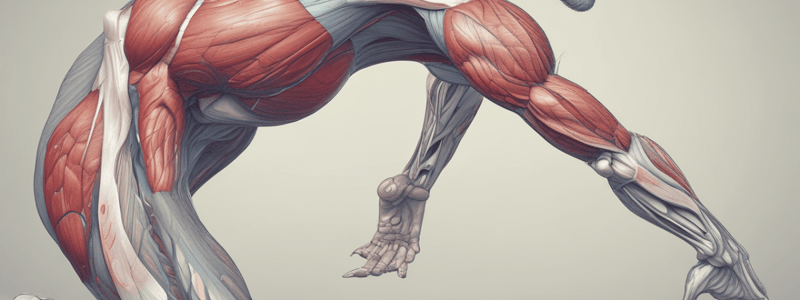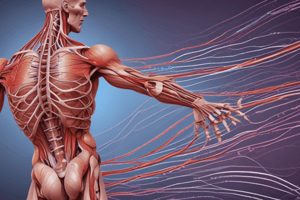Podcast
Questions and Answers
What is the energy configuration of the myosin head when it is bound to ATP?
What is the energy configuration of the myosin head when it is bound to ATP?
- Low energy configuration (correct)
- Variable energy configuration
- High energy configuration
- Neutral energy configuration
What is the result of calcium binding to troponin?
What is the result of calcium binding to troponin?
- The actin binding site is closed
- The myosin head is in a low energy configuration
- The actin binding site is opened (correct)
- The myosin head is in a high energy configuration
What is the role of SERCA1a in excitation-contraction coupling?
What is the role of SERCA1a in excitation-contraction coupling?
- To transmit nerve impulses to the muscle fiber
- To release calcium ions from the sarcoplasmic reticulum
- To generate muscle contraction
- To pump calcium ions back into the sarcoplasmic reticulum (correct)
What is the outcome of the myosin head cleaving ATP into ADP + P?
What is the outcome of the myosin head cleaving ATP into ADP + P?
Which term correctly describes the overall process which transforms a nerve impulse into a muscle contraction?
Which term correctly describes the overall process which transforms a nerve impulse into a muscle contraction?
What happens to ADP after the power stroke?
What happens to ADP after the power stroke?
What is the term for when the myosin head moves from a high energy state to a low energy state, causing actin to be pulled closer to the M-line?
What is the term for when the myosin head moves from a high energy state to a low energy state, causing actin to be pulled closer to the M-line?
What is the term for when the myosin heads bend towards the center of the sarcomere?
What is the term for when the myosin heads bend towards the center of the sarcomere?
What is the primary function of RyRs in excitation-contraction coupling?
What is the primary function of RyRs in excitation-contraction coupling?
What is the role of DHPR in excitation-contraction coupling?
What is the role of DHPR in excitation-contraction coupling?
What is the term for when myosin is still attached to actin?
What is the term for when myosin is still attached to actin?
What is the outcome of the action potential causing a conformational change in the DHPR?
What is the outcome of the action potential causing a conformational change in the DHPR?
What is the name of the theory that describes actin-myosin binding for muscle contractions?
What is the name of the theory that describes actin-myosin binding for muscle contractions?
Which is the correct order of events, in regards to excitation-contraction coupling?
Which is the correct order of events, in regards to excitation-contraction coupling?
What is the primary function of the sarcoplasmic reticulum?
What is the primary function of the sarcoplasmic reticulum?
Which is the correct order of events, in regards to the "walk along theory"?
Which is the correct order of events, in regards to the "walk along theory"?
Flashcards are hidden until you start studying
Study Notes
Excitation-Contraction Coupling: General Info
- Excitation-contraction coupling transforms a nerve impulse into a muscle contraction.
- T-Tubules are associated with the sarcoplasmic reticulum, which stores calcium.
- The sarcoplasmic reticulum consists of terminal cisternae and longitudinal tubules surrounding myofibrils.
- DHPR (dihydropyridine receptors) are voltage-sensing proteins mechanically coupled to RyRs (ryanodine receptors).
- RyRs are calcium channels on the sarcoplasmic reticulum membrane.
- Muscle contraction continues as long as calcium ion concentration remains high.
- SERCA1a (sarcoplasmic reticulum calcium ATPase) is a calcium pump continuously active in the sarcoplasmic reticulum walls.
Excitation-Contraction Coupling: Steps
- Action potential travels from the motor end plate to the sarcolemma.
- The action potential depolarizes the T-Tubule and penetrates the cell.
- DHPR conformational change triggers RyRs calcium channels to open.
- Calcium rapidly diffuses out of the sarcoplasmic reticulum.
- Muscle contraction is initiated.
- SERCA1a removes calcium ions from the myofibrillar fluid after contraction.
Walk Along Theory (of muscle contractions): General Info
- Myosin head bound to ATP is in a low energy configuration.
- Myosin head cleaves ATP into ADP + P, forming a "cocked position" in a high energy configuration.
Walk Along Theory (of muscle contractions): Steps
- Myosin head binds to ATP, entering a low energy configuration.
- Myosin head cleaves ATP, cocking into a high energy configuration.
- Calcium binds to troponin, opening the actin binding site.
- Myosin head binds to actin, forming the cross bridge.
- Cross bridging triggers Myosin to release the phosphate group, leaving ADP attached.
- Power stroke occurs, moving myosin from high to low energy state, causing actin to pull closer to the M-line (micro-contraction).
- ADP detaches from myosin, leaving it in a rigor state.
- ATP binds to the myosin head group.
- Myosin detaches from actin.
Studying That Suits You
Use AI to generate personalized quizzes and flashcards to suit your learning preferences.




